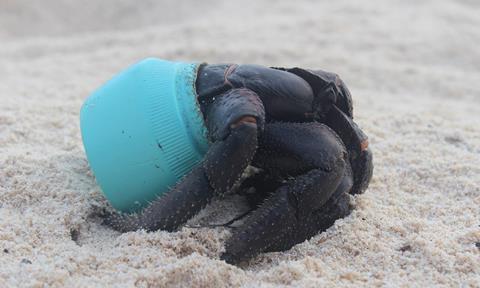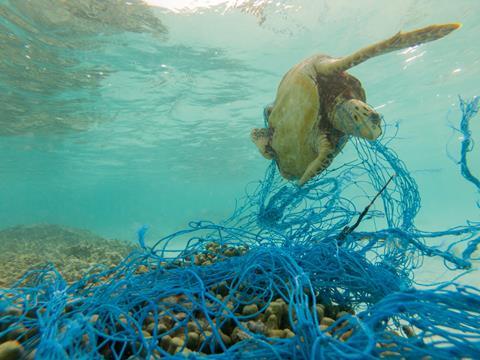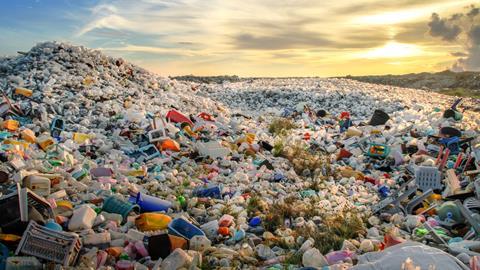Meet the scientists with novel ideas for tackling plastic pollution
In 2015, two scientists turned up on a remote island in the South Pacific. They chose this uninhabited place, oddly enough, to carry out a trash survey. But it took them three months, and the results were shocking. Henderson Island was more densely covered in plastic than almost anywhere ever surveyed. The scientists counted over 37 million pieces, with thousands more washing up on the beaches every day, and that only included those big enough to spot. They discovered the island was acting as a ‘reservoir’ for the world’s waste.

Plastic waste in the oceans is increasingly touching the public consciousness. In the UK, the television documentary Blue planet II played an important role in raising awareness of the issue and its effects on marine life. Consider that since people started producing plastic in the middle of the 20th century, we have put an estimated 8300 million tons into circulation. Roughly a third is still being used, while the rest – except for a small proportion that is recycled – has become waste. Research published in 2017 suggests 4900 million tons are now lingering in landfill, waterways and elsewhere. It would take 155 years just to count to that number. Plus, in 2015 and 2016 alone, we added more freshly produced plastic to the mix than we’ve ever managed to recycle.
The reason there’s so much still hanging around is also why plastic is so useful. It’s durable; it lasts a long time. That’s great for making toothbrushes, flip-flops and fishing nets that don’t disintegrate after the first use, but bad for the environment.
The structure of some types of plastic is what makes them so resistant to degradation. In the poly(ethylene terephthalate) (PET) used in plastic bottles, long chains of repeating polymer units stack in a repeating, crystalline structure. It’s this structure that makes the plastic very strong. As the University of Portsmouth’s John McGeehan, explains. ‘The more crystalline the plastic is, the harder it is to break down,’ he says. ‘So that’s what makes plastic bottles particularly difficult.’

In your class
Download the text of this article (MS Word or pdf), all the teaching ideas as a single file (MS Word or pdf), or all the downloads in one zip file.
Polymer chemistry is a core chemistry topic that applies prior knowledge of key concepts such as bonding and basic organic chemistry. Recent syllabus changes have added challenge to this area. Using this article in class capitalises on the considerable attention plastic waste has gained in popular media. This article adds a new dimension to ideas about recycling and life-cycle assessments. The mention of enzymes to tackle the polymer waste problem means this is a useful cross-curricular article, showing how cutting-edge science is often interdisciplinary. It could be used in both chemistry and biology lessons.
Smaller plastics, big problems
In the oceans, plastic does get broken up, but only into smaller and smaller pieces, which become microplastics (less than 5 millimetres) and eventually nanoplastics (1–100 nanometres). These collect pollution, making them harmful to grazing sea creatures. Microplastics are tricky to spot, which is why they weren’t accounted for in the Henderson Island study, and you’d need a microscope to see nanoplastics.
Several studies in recent years have sampled microplastic density in oceans, with estimates ranging from 10,000 to 100,000 fragments per square kilometre. However, research on nanoplastic waste is limited. ‘We do not know the concentration of nanoplastic in the environment,’ according to Alexandra Ter Halle, a chemist at the Université Paul Sabatier in France.
Alexandra was involved in a study that found PET nanoplastic and larger quantities of poly(vinylchloride) (PVC) nanoplastic floating in the North Atlantic Ocean. PVC is used in window frames and water pipes. Alexandra explains nanoplastics behave differently to larger pieces of plastic, for instance, in terms of how they interact with marine life, but there is still a lot of work to be done to understand how.
Tackling the crisis

Consumers can help stop so much plastic piling up and washing out to sea, but it’s not just down to them. Policymakers also need to encourage behaviour change. More policies like charging for plastic carrier bags and the recently announced single-use plastic ban, which targets items like straws and plastic stirrers, are needed, as well as restrictions on plastics used in industries like fishing.
There are also some novel plastic recycling solutions under development. In 2016, Japanese scientists discovered a bug that ‘eats’ PET. The bug uses the carbon in plastic as an energy source, chowing it down with an enzyme that appears to have evolved since the invention of plastic. ‘This enzyme breaks the ester bonds in the [PET] and releases the building blocks,’ John explains. ‘So if you put a plastic bottle into a vat of enzyme, you would see it dissolve and turn into a clear plastic solution.’ John’s team has been working to improve the enzyme so it could be used to break down plastic waste in the same way enzymes added to washing powder break down stains in clothes. Although it’s not industry-ready yet, he’s hoping to build a heat-tolerant version that could eat through melted plastic, enabling it to get to work much faster.
However, John admits his enzyme is ‘not going to solve’ the plastic problem. Solutions will involve government, industry and consumers, as well as scientists, all tackling plastic waste together. According to Alexandra, we ‘must focus on prevention’ to reduce plastic waste. ‘In the next five years we are going to release into the ocean 110 million tons of plastic,’ she says. ‘The figures speak for themselves.’

Polydensity bottle
Hands-on density and recycling reasoning activity, ages 11–14.
This activity uses a simple demonstration piece to stimulate scientific thinking. Pupils make observations of bottles containing beads and liquids of different densities in various states and use these to draw conclusions and then apply these to the real world context of separating mixed plastics. Download the teacher instructions (MS Word or pdf) and student worksheet (MS Word or pdf).
Article by Hayley Bennett, a science writer based in Bristol, UK. Resources by Kristy Turner, University of Manchester and Bolton School.
In your class
Download this article and all of these teaching ideas and resources from: rsc.li/2onq9LT
Polymer chemistry is a core chemistry topic that applies prior knowledge of key concepts such as bonding and basic organic chemistry. Recent syllabus changes have added challenge to this area. Using this article in class capitalises on the considerable attention plastic waste has gained in the popular media. This article adds a new dimension to ideas about recycling and life-cycle assessments. The mention of enzymes to tackle the polymer waste problem means this is a useful cross-curricular article, showing how cutting-edge science is often interdisciplinary. This article could be used in both chemistry and biology lessons.
Relevant to your syllabus
Download a list of specification points this article supports from the Education in Chemistry website: rsc.li/2onq9LT.
Polydensity bottle
Hands-on density and recycling reasoning activity, ages 11–14
This activity uses a simple demonstration piece to stimulate scientific thinking. Pupils make observations of bottles containing beads and liquids of different densities in various states and use these to draw conclusions and then apply these to the real world context of separating mixed plastics. Download the teacher instructions and student worksheet from the Education in Chemistry website: rsc.li/2onq9LT.
More recommended resources
- This challenge has pupils develop a product that can be easily made from recycled plastic: rsc.li/2MZjpl7
- The ‘Polymers in everyday things’ chapter from Inspirational chemistry contains information sheets, experiments and teaching resources: rsc.li/2PjLpgT
- A practical activity investigating plastics and green chemistry, suitable as an outreach or science day activity: //rsc.li/2LG7Fzk
- The Starters for 10 polymer chapter includes worksheets and practice questions: rsc.li/2PQqu6f
- This online materials chemistry CPD course includes plastics: rsc.li/2LFreHW
More recommended resources
- This challenge has pupils develop a product easily made from recycled plastic.
- The ‘Polymers in everyday things’ chapter from Inspirational chemistry contains information sheets, experiments and teaching resources.
- A practical activity investigating plastics and green chemistry, suitable as an outreach or science day activity.
- The Starters for 10 polymer chapter includes worksheets and practice questions.
- This online materials chemistry CPD course includes plastics.
Downloads
Specification links
Word, Size 56.77 kbSpecification links
PDF, Size 48.07 kbArticle
Word, Size 55.95 kbArticle
PDF, Size 51.21 kbAll teaching ideas
Word, Size 56.89 kbAll teaching ideas
PDF, Size 57.13 kbPolydensity bottle: student handout
Word, Size 0.25 mbPolydensity bottle: student handout
PDF, Size 0.16 mbPolydensity bottle: teacher notes
Word, Size 55.11 kbPolydensity bottle: teacher notes
PDF, Size 52.83 kbAll downloads
Zip, Size 0.64 mb











1 Reader's comment